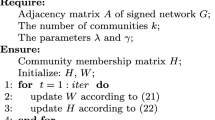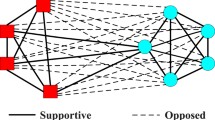Abstract
Community detection is a fundamental task in the social network analysis field, which is beneficial for many real-world applications such as recommendation systems and telephone fraud detection. Community detection in unsigned networks has been extensively studied, however, few works focus on community detection in signed networks. Under this background, we propose a framework based on regularized semi-nonnegative matrix tri-factorization which maps the signed network from high-dimensional space to low-dimensional space, such that the communities of the signed network can be derived. In addition, to improve the detection accuracy, we introduce a graph regularization to distribute the pair of nodes which are connected with negative links into different communities. The experimental results on both synthetic datasets and real-world datasets verify the effectiveness of the proposed method.




Similar content being viewed by others
References
Tang L, Liu H Community detection and mining in social media. www.morganclaypool.com
Sageman M (2004) Understanding terror networks. University of Pennsylvania Press, Philadelphia
Xu J, Chen H (2005) CrirnelNet explorer: a framework for criminal network knowledge discovery. ACM Trans Inf Syst 23(2):201–226
Chen H, Chung W, Xu JJ et al (2004) Crime data mining: a general framework and some examples. Computer 37(4):50–56
Fortunato S (2010) Community detection in graphs. Phys Rep 486(3):75–174
Girvan M, Newman MEJ (2002) Community structure in social and biological networks. Proc Natl Acad Sci 99(12):7821– 7826
Greene D, Cunningham P (2013) Producing a unified graph representation from multiple social network views. In: Proceedings of the 5th annual ACM web science conference, pp 118–121
Doreian P, Mrvar A (1996) A partitioning approach to structural balance. Soc Netw 18(2):149–168
Kunegis J, Preusse J, Schwagereit F (2013) What is the added value of negative links in online social networks? In: International conference on world wide web, pp 727–736
Tang J, Aggarwal C, Liu H (2012) A survey of mining signed networks in social media. In: IEEE transactions on knowledge and data engineering
Pei Y, Chakraborty N, Sycara K (2015) Nonnegative matrix tri-factorization with graph regularization for community detection in social networks. In: International conference on artificial intelligence. AAAI Press
Chiang KY, Hsieh CJ, Natarajan N et al (2014) Prediction and clustering in signed networks: a local to global perspective. J Mach Learn Res 15(1):1177–1213
Wu L, Ying XW, Wu XT et al (2011) Spectral analysis of kbalance signed graphs. In: Advances in knowledge discovery and data mining, pp 1–12
Kunegis J, Schmidt S, Lommatzsch A et al (2010) Spectral analysis of signed graphs for clustering, prediction and visualization. In: Siam international conference on data mining, SDM 2010, pp 975–978
Chiang K-Y, Whang JJ, Dhillon IS (2012) Scalable clustering of signed networks using balance normalized cut. In: Proceedings of the 21st ACM international conference on information and knowledge management. ACM
Anchuri P, Magdon-Ismail M (2012) Communities and balance in signed networks: a spectral approach. In: 2012 IEEE/ACM international conference on advances in social networks analysis and mining (ASONAM), pp 235–242
Newman ME, Girvan M (2004) Finding and evaluating community structure in networks. Phys Rev E 69 (2):026113
Liu C, Liu J, Jiang Z (2014) A multiobjective evolutionary algorithm based on similarity for community detection from signed social networks. IEEE Trans Cybern 44(12):2274–2287
Amelio A, Pizzuti C (2013) Community mining in signed networks: a multiobjective approach. In: IEEE/ACM international conference on advances in social networks analysis and mining, pp 95–99
Chen Y, Wang X-l, Yuan B (2013) Overlapping community detection in signed networks. arXiv:1310-4023
Yang B, Cheung WK, Liu J (2007) Community mining from signed social networks. IEEE Trans Knowl Data Eng 19(10): 1333–1348
Lee DD, Sebastian Seung H (2001) Algorithms for nonnegative matrix factorization. In: Advances in neural information processing systems, pp 556–562
Wang F, Li T, Wang X et al (2011) Community discovery using nonnegative matrix factorization. Data Min Knowl Disc 22(3):493–521
Chris D, Tao LI, Jordan MI (2010) Convex and seminonnegative matrix factorizations. In: IEEE transactions on pattern analysis and machine intelligence
Yokoya N, Chanussot J, Iwasaki A (2014) Nonlinear unmixing of hyperspectral data using semi-nonnegative matrix factorization. IEEE Trans Geosci Remote Sens 52(2):1430–1437
Mo Q, Draper BA (2012) Semi-nonnegative matrix factorization for motion segmentation with missing data. Lect Notes Comput Sci 7578(1):402–415
Strehl A, Ghosh J (2003) Cluster ensemble-a knowledge reuse framework for combining multiple partitions. J Mach Learn 3:583–617
Lin W, Kong X, Yu PS et al (1948) Community detection in incomplete information networks. N Engl J Med 319(5):313–324
Gmez S, Jensen P, Arenas A (2009) Analysis of community structure in networks of correlated data. Phys Rev E 80(1):016114
Kropivnik S, Mrvar A (1996) An analysis of the slovene parliamentary parties network. In: Proceedings of develop data analysis, pp 209–216
Read KE (1954) Cultures of the central highlands, New Guinea. Southwest J Anthropol 1:1–43
Acknowledgements
This work was supported by the National Natural Science Foundation of China (No.61473149, No.61301159), Natural Science Foundation of Jiangsu Province, China (No. BK20140073) and China Postdoctoral Science Foundation (No.2015M571635, No. 2016T90404).
Author information
Authors and Affiliations
Corresponding author
Rights and permissions
About this article
Cite this article
Li, Z., Chen, J., Fu, Y. et al. Community Detection Based on Regularized Semi-Nonnegative Matrix Tri-Factorization in Signed Networks. Mobile Netw Appl 23, 71–79 (2018). https://doi.org/10.1007/s11036-017-0883-0
Published:
Issue Date:
DOI: https://doi.org/10.1007/s11036-017-0883-0




